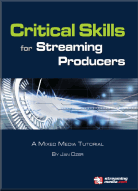 Now in its eleventh year, the Streaming Media East 2008 show is being held this week again at the Hilton New York.
Now in its eleventh year, the Streaming Media East 2008 show is being held this week again at the Hilton New York.
It's a three-day event, with preconference workshops on Monday and two days of conference sessions and exhibits. The show fits well in the Hilton, feeling similar in size to the over 3,000 attendees last year, but up to some 65 exhibitors this year, requiring more space as some booths spilled out into the adjoining hallway. Dan Rayburn organized another great conference, with more than 100 speakers and 34 sessions (in three parallel tracks), with focus on major media companies and corporate users sharing their experiences with online media.
One clear focus at the show was on Adobe Flash and Microsoft Silverlight, as streaming formats have become part of the overall interactive Web experience -- with On2 VP6 still in the mix as well, especially in mobile devices. (The old format battle between Windows Media and RealMedia and QuickTime that was so exciting just a few ago is now such old news, part of the murky past of the streaming industry.)
In particular, well-known author Jan Ozer presented a great session comparing streaming codecs. He started with the results of his ongoing "unscientific" analysis of the video formats used on major websites, concluding that Adobe Flash has grown dramatically in broadcast from the previous parity with Microsoft Windows Media Video, but that WMV still has a lead in corporate use.
Ozer first looked at implementations of H.264 / MPEG-4 AVC, concluding that the Main Concept codec (as used by Rhozet Carbon Coder, Sorenson Squeeze, and Adobe Premiere Pro and other Creative Suite applications) was best, followed by Dicas (Telestream Episode Pro), and again lagged by Apple (as in Final Cut Studio and Compressor), which seems to be standing still in H.264 quality.
Ozer then compared the H.264, Microsoft VC-1 (Windows Media Video), and On2 VP6 codecs under low data rates, for both HD and SD content, evaluating still and motion quality and frame rate. He concluded that H.264 did best, especially keeping more detail. On2 VP6 also did well, especially with quieter motion backgrounds. And WM/VC-1 continued to lag, even dropping frames.
Ozer also had a preview of the newly improved On2 VP6 codec, concluding that it provided better detail for HD and was quieter in terms of motion artifacts for SD -- though not the "as much as 40%" improvement promised by the press release.
Ozer illustrated his presentation with frame captures comparing the results from each codec. And he concluded with a sneak peek at the raw data behind his analysis of the major streaming sizes, including video resolutions and data rates used by what he categorized as conservative, mid-range, and aggressive users of video.
 If you want to know more, including all the gory details on getting the best compression for streaming video, check out Ozer's new publication, Critical Skills for Streaming Producers -- a mixed-media DVD tutorial priced at $249. It includes a 340-page PDF book, plus 27 screencam tutorials demonstrating software tools, 9 tutorial videos, 75 sample videos demonstrating compression options, and 13 checklists. The book also includes the extensive market research data of video usage on major broadcast and corporate sites.
If you want to know more, including all the gory details on getting the best compression for streaming video, check out Ozer's new publication, Critical Skills for Streaming Producers -- a mixed-media DVD tutorial priced at $249. It includes a 340-page PDF book, plus 27 screencam tutorials demonstrating software tools, 9 tutorial videos, 75 sample videos demonstrating compression options, and 13 checklists. The book also includes the extensive market research data of video usage on major broadcast and corporate sites.
